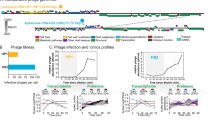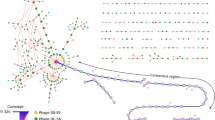Abstract
Interactions between bacterial hosts and their viruses (phages) lead to reciprocal genome evolution through a dynamic co-evolutionary process1,2,3,4,5. Phage-mediated transfer of host genes—often located in genome islands—has had a major impact on microbial evolution1,4,6. Furthermore, phage genomes have clearly been shaped by the acquisition of genes from their hosts2,3,5. Here we investigate whole-genome expression of a host and phage, the marine cyanobacterium Prochlorococcus MED4 and the T7-like cyanophage P-SSP7, during lytic infection, to gain insight into these co-evolutionary processes. Although most of the phage genome was linearly transcribed over the course of infection, four phage-encoded bacterial metabolism genes formed part of the same expression cluster, even though they are physically separated on the genome. These genes—encoding photosystem II D1 (psbA), high-light inducible protein (hli), transaldolase (talC) and ribonucleotide reductase (nrd)—are transcribed together with phage DNA replication genes and seem to make up a functional unit involved in energy and deoxynucleotide production for phage replication in resource-poor oceans. Also unique to this system was the upregulation of numerous genes in the host during infection. These may be host stress response genes and/or genes induced by the phage. Many of these host genes are located in genome islands and have homologues in cyanophage genomes. We hypothesize that phage have evolved to use upregulated host genes, leading to their stable incorporation into phage genomes and their subsequent transfer back to hosts in genome islands. Thus activation of host genes during infection may be directing the co-evolution of gene content in both host and phage genomes.
This is a preview of subscription content, access via your institution
Access options
Subscribe to this journal
Receive 51 print issues and online access
$199.00 per year
only $3.90 per issue
Buy this article
- Purchase on Springer Link
- Instant access to full article PDF
Prices may be subject to local taxes which are calculated during checkout



Similar content being viewed by others
References
Canchaya, C., Proux, C., Fournous, G., Bruttin, A. & Brussow, H. Prophage genomics. Microbiol. Mol. Biol. Rev. 67, 238–276 (2003)
Filee, J., Forterre, P. & Laurent, J. The role played by viruses in the evolution of their hosts: a view based on informational protein phylogenies. Res. Microbiol. 154, 237–243 (2003)
Hendrix, R. W., Lawrence, J. G., Hatfull, G. F. & Casjens, S. The origins and ongoing evolution of viruses. Trends Microbiol. 8, 504–508 (2000)
Hsiao, W. W. L. et al. Evidence of a large novel gene pool associated with prokaryotic genome islands. PLoS Genet. 1, e62 (2006)
Lindell, D. et al. Transfer of photosynthesis genes to and from Prochlorococcus viruses. Proc. Natl Acad. Sci. USA 101, 11013–11018 (2004)
Coleman, M. L. et al. Genomic islands and the ecology and evolution of Prochlorococcus. Science 311, 1768–1770 (2006)
Partensky, F., Hess, W. R. & Vaulot, D. Prochlorococcus, a marine photosynthetic prokaryote of global significance. Microbiol. Mol. Biol. Rev. 63, 106–127 (1999)
Breitbart, M., Miyake, J. H. & Rohwer, F. Global distribution of nearly identical phage-encoded DNA sequences. FEMS Microbiol. Lett. 236, 249–256 (2004)
Mann, N. H. et al. The genome of S-PM2, a “photosynthetic” T4-type bacteriophage that infects marine Synechococcus. J. Bacteriol. 187, 3188–3200 (2005)
Millard, A., Clokie, M. R., Shub, D. A. & Mann, N. H. Genetic organization of the psbAD region in phages infecting marine Synechococcus strains. Proc. Natl Acad. Sci. USA 101, 11007–11012 (2004)
Sullivan, M. B., Coleman, M., Weigele, P., Rohwer, F. & Chisholm, S. W. Three Prochlorococcus cyanophage genomes: Signature features and ecological interpretations. PLoS Biol. 3, e144 (2005)
Lindell, D., Jaffe, J. D., Johnson, Z. I., Church, G. M. & Chisholm, S. W. Photosynthesis genes in marine viruses yield proteins during host infection. Nature 438, 86–89 (2005)
Clokie, M. R. J., Shan, J., Bailey, S., Jia, Y. & Krisch, H. M. Transcription of a 'photosynthetic' T4-type phage during infection of a marine cyanobacterium. Environ. Microbiol. 8, 827–835 (2006)
Zeidner, G. et al. Potential photosynthesis gene recombination between Prochlorococcus and Synechococcus via viral intermediates. Environ. Microbiol. 7, 1505–1513 (2005)
Sullivan, M. B. et al. Prevalence and evolution of core photosystem II genes in marine cyanobacterial viruses and their hosts. PLoS Biol. 4, e234 (2006)
Molineux, I. in The Bacteriophages (ed. Calendar, R.) 277–301 (Oxford University Press, New York, 2005)
Chen, Z. & Schneider, T. D. Information theory based T7-like promoter models: classification of bacteriophages and differential evolution of promoters and their polymerases. Nucleic Acids Res. 33, 6172–6187 (2005)
Miller, E. S. et al. Bacteriophage T4 genome. Microbiol. Mol. Biol. Rev. 67, 86–156 (2003)
Lenski, R. E. & Levin, B. R. Constraints on the coevolution of bacteria and virulent phage: A model, some experiments, and predictions for natural communities. Am. Nat. 124, 585–602 (1985)
Tabor, S., Huber, H. E. & Richardson, C. C. Escherichia coli thioredoxin confers processivity on the DNA polymerase activity of the gene 5 protein of bacteriophage T7. J. Biol. Chem. 262, 16212–16223 (1987)
Tilly, K., Murialdo, H. & Georgopoulos, C. P. Identification of a second Escherichia coli groE gene whose product is necessary for bacteriophage morphogenesis. Proc. Natl Acad. Sci. USA 78, 1629–1633 (1981)
Ueno, H. & Yonesaki, T. Phage-induced change in the stability of mRNAs. Virology 329, 134–141 (2004)
Tolonen, A. C. et al. Global gene expression of Prochlorococcus ecotypes in response to changes in nitrogen availability. Mol. Systems Biol. 2, 53 (2006)
Irizarry, R. A. et al. Summaries of Affymetrix GeneChip probe level data. Nucleic Acids Res. 31, e15 (2003)
Jaffe, J. D. et al. The complete genome and proteome of Mycoplasma mobile. Genome Res. 14, 1447–1461 (2004)
Acknowledgements
We thank C. Steglich, S. Bhattacharya, H. Keller, L. Thompson, P. Weigele, S. Choe, D. Endy, S. Kosuri, M. Shmoish and J. Aach for discussions, and J. Waldbauer and M. Osburne for comments on the manuscript, and the MIT Center for Environmental Health Sciences. This work was funded by the DOE Genomes to Life System Biology Center Grant (G.M.C. and S.W.C.), the Gordon and Betty Moore Foundation’s Marine Microbiology Program (S.W.C.), and the National Science Foundation (S.W.C).
The microarray data have been deposited in the GEO database under the accession number GSE8382.
Author information
Authors and Affiliations
Corresponding author
Ethics declarations
Competing interests
Reprints and permissions information is available at www.nature.com/reprints. The authors declare no competing financial interests.
Supplementary information
Supplementary Information
This file contains Supplementary Methods with details of the experimental methodology and additional references; Supplementary Tables 1-8 and Supplementary Figures 1-10 with Legends showing proteomic and promoter results, list of upregulated host genes, phage gene expression cluster analysis and significance, hli gene expression table, RT-PCR verification of microarray results and normalization methods, comparison of phage quantification methods to quantitative PCR results and lists of primers used in this study (PDF 1691 kb)
Rights and permissions
About this article
Cite this article
Lindell, D., Jaffe, J., Coleman, M. et al. Genome-wide expression dynamics of a marine virus and host reveal features of co-evolution. Nature 449, 83–86 (2007). https://doi.org/10.1038/nature06130
Received:
Accepted:
Issue Date:
DOI: https://doi.org/10.1038/nature06130
This article is cited by
-
Exploring virus-host-environment interactions in a chemotrophic-based underground estuary
Environmental Microbiome (2024)
-
Abundant and cosmopolitan lineage of cyanopodoviruses lacking a DNA polymerase gene
The ISME Journal (2023)
-
Virus–pathogen interactions improve water quality along the Middle Route of the South-to-North Water Diversion Canal
The ISME Journal (2023)
-
Biogeochemical sulfur cycling of virus auxiliary metabolic genes involved in Napahai plateau wetland
Environmental Science and Pollution Research (2023)
-
Crop management shapes the diversity and activity of DNA and RNA viruses in the rhizosphere
Microbiome (2022)
Comments
By submitting a comment you agree to abide by our Terms and Community Guidelines. If you find something abusive or that does not comply with our terms or guidelines please flag it as inappropriate.



